
Droseraceae is a family of carnivorous flowering plants, also known as the sundew family. It consists of approximately 180 species in three extant genera. Representatives of the Droseraceae are found on all continents except Antarctica.
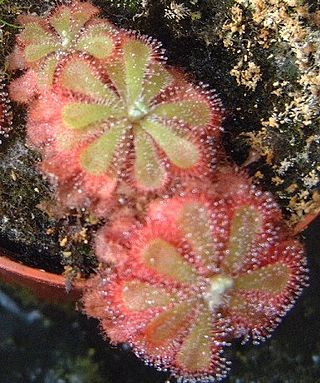
Drosera aliciae, the Alice sundew, is a carnivorous plant in the family Droseraceae. It is native to the Cape Provinces of South Africa, like Drosera capensis, the cape sundew, and is one of the most common sundews in cultivation. The plant forms small, tight rosettes of wedge-shaped leaves, up to 5 cm in diameter. Under conditions of good lighting, the insect-snagging tentacles will become deeply coloured with anthocyanin pigments, which probably aid in its attraction of insect prey. The plant is relatively easy to grow, and produces attractive scapes of pink flowers, which are held about 30 cm away from the carnivorous leaves, so as to prevent pollinators from becoming ensnared. D. aliciae is very similar in form to a number of other closely related species such as D. slackii, and D. natalensis: the former is rather larger with a slightly different growth habit(8 cm diameter); the latter has hairier stipules and a larger distance between leaf base and the “sticky” trichomes.

Drosera regia, commonly known as the king sundew, is a carnivorous plant in the sundew genus Drosera that is endemic to a single valley in South Africa. The genus name Drosera comes from the Greek word droseros, meaning "dew-covered". The specific epithet regia is derived from the Latin for "royal", a reference to the "striking appearance" of the species. Individual leaves can reach 70 cm (28 in) in length. It has many unusual relict characteristics not found in most other Drosera species, including woody rhizomes, operculate pollen, and the lack of circinate vernation in scape growth. All of these factors, combined with molecular data from phylogenetic analysis, contribute to the evidence that D. regia possesses some of the most ancient characteristics within the genus. Some of these are shared with the related Venus flytrap (Dionaea muscipula), which suggests a close evolutionary relationship.

Drosera adelae, commonly known as the lance-leaved sundew, is a carnivorous plant in the genus Drosera that is endemic to Queensland, Australia.
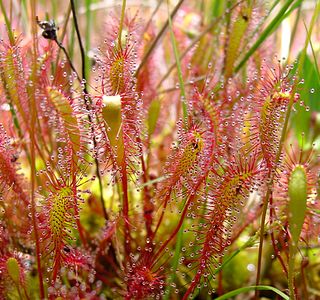
Drosera anglica, commonly known as the English sundew or great sundew, is a carnivorous flowering plant species belonging to the sundew family Droseraceae. It is a temperate species with a circumboreal range, although it does occur as far south as Japan, southern Europe, and the island of Kauai in Hawaii, where it grows as a tropical sundew. It is thought to originate from an amphidiploid hybrid of D. rotundifolia and D. linearis, meaning that a sterile hybrid between these two species doubled its chromosomes to produce fertile progeny which stabilized into the current D. anglica.

Drosera nidiformis is tropical African sundew. This plant is indigenous to KwaZulu-Natal in South Africa. Its classification is ambiguous; some sources refer to it as a synonym of Drosera dielsiana whereas others treat it as a separate species. This plant was previously known as Drosera "maglisburg".

Drosera indica is an insectivorous plant, a sundew native to tropical countries throughout the world, from Asia to Africa, but absent from the neotropics. Together with Australian endemic species D. aquatica, D. aurantiaca, D. barrettorum, D. cucullata, D. finlaysoniana, D. fragrans, D. glabriscapa, D. hartmeyerorum, D. nana, D. serpens it makes up the section Arachnopus.

Drosera monticola is a perennial carnivorous plant species in the genus Drosera, the sundews. This species is endemic to a single mountain range in Western Australia.
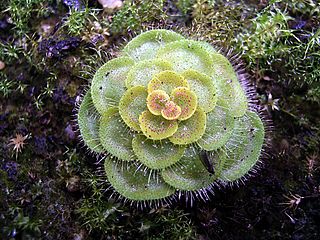
Drosera zonaria, the painted sundew, is a perennial tuberous species in the carnivorous plant genus Drosera and is endemic to south-west Western Australia from near Perth southeast to near Esperance. It grows in a tight rosette approximately 5 to 7 cm in diameter with 20 to 30 green to red leaves that are arranged in concentric layers. The leaves are typically 1 cm wide and are usually described as being "kidney-shaped" with crimson leaf margins. It grows in deep silica sands in open woodland or coastal heathland and only flowers after a bush fire, which is speculated to be caused by the release of ethylene. Its white, sweetly perfumed flowers, which are very similar to those of D. erythrorhiza, emerge on 4 to 5 cm tall scapes. As with most other tuberous Drosera species, D. zonaria will die back during the dry summer months and retreat to the fleshy tuber 10 to 30 cm below ground.

Drosera slackii is a subtropical sundew native to the Cape Provinces of South Africa. It forms rosettes that range from to two to four inches in diameter, and produces pink flowers. It is named after the British plantsman and author Adrian Slack (1933-2018).

Drosera sect. Erythrorhiza is a section of 14 species of tuberous species in the genus Drosera. It represents a natural group of all the rosetted tuberous Drosera. Most species are endemic to Western Australia, but D. aberrans, D. praefolia, D. schmutzii, and D. whittakeri are also found in eastern Australia.

Drosera bicolor is an erect perennial tuberous species in the genus Drosera that is endemic to Western Australia. It produces a basal rosette of leaves similar to that of D. peltata and the stem grows to 11 cm (4 in) high. Its white flowers that have a red spot near the petal base emerge from September to October. D. bicolor grows in deep silica sand on heathland along the upper Phillips River and south-east of Lake King.

Drosera gigantea, the giant sundew, is an erect perennial tuberous species in the carnivorous plant genus Drosera that is endemic to Western Australia. It grows in sandy soils at the margins of swamps and near granite outcrops along the Western Australian coast from Albany north to just south of Geraldton. D. gigantea produces small shield-shaped leaves along many lateral branches that look like a small tree. Individual plants can grow up to 0.2–1 m (0.7–3.3 ft) tall. Because of its tall, tree-like form, it is considered one of the largest Drosera species. It is also easily cultivated and enjoys damp, humid conditions often provided in greenhouses. White flowers emerge from August to November. The red tubers of this species can grow to be 3.8 cm (1.5 in) in diameter and may be a metre below ground.

Alastair S. Robinson is a taxonomist and field botanist specialising in the carnivorous plant genus Nepenthes, for which he is regarded as a world authority. He is currently Manager Biodiversity Services at the National Herbarium of Victoria, Royal Botanic Gardens Melbourne, where he oversees identification botany services, the Library and Artwork components of the State Botanical Collection, and the botanical journal Muelleria, a peer-reviewed scientific journal on botany published by the Royal Botanic Gardens Victoria, for which he is Editor in Chief.
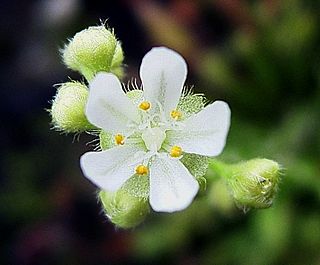
Drosera dilatato-petiolaris is a carnivorous plant in the genus Drosera and is endemic to Australia, being found in both Western Australia and the Northern Territory. Its leaves are arranged in a rosette and commonly produces plantlets, eventually forming large clumps that can be over 1 ft (0.3 m) across. Green petioles emerging from the center of the rosette are typically 3–5 mm wide, but can vary. Red carnivorous leaves at the end of the petioles are small and round, with most resting on the soil surface. Inflorescences are 18 cm (7 in) long with white flowers being produced from April to May. It has a diploid chromosome number of 2n = 12.
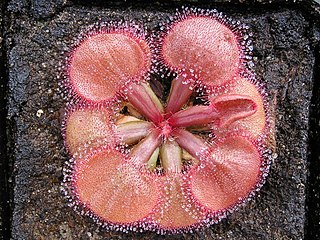
Drosera falconeri is a carnivorous plant in the genus Drosera. It is endemic to the Northern Territory of Australia.

Drosera subg. Lasiocephala, sometimes collectively known as the petiolaris-complex, is a subgenus of 14 species in the genus Drosera. These species are distinguished by their subpeltate to peltate lamina.
Drosera viridis is a semi-erect or rosetted perennial species in the carnivorous plant genus Drosera. It is known only from Brazil, being found in eastern Paraná and São Paulo and central Santa Catarina at elevations from 550–1,100 m (1,800–3,610 ft). It may, however, also be found in adjacent Argentina, Paraguay, and Uruguay. It typically grows in waterlogged habitats among grasses in white-clayey, reddish lateritic, or humus-rich black-brown soils and is sometimes found submerged with only the leaves above water.

Drosera trinervia is a species in the carnivorous plant genus Drosera that is endemic to the Cape Provinces of South Africa. It was first described by Kurt Polycarp Joachim Sprengel in his 1820 work Neue Entdeckungen im ganzen Umfang der Pflanzenkunde.
Drosera nivea is a species of carnivorous plant. It is a pygmy sundew and is native to Western Australia. The specific epithet nivea is derived from the Latin word niveus, meaning white, in reference to the colour of the plant's flower. It is closely related to Drosera citrina and has previously been considered a variety of D.citrina known as D. citrina var. nivea.



















